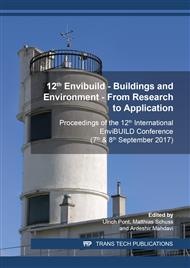p.327
p.335
p.344
p.353
p.361
p.369
p.374
p.385
p.393
Waste Prevention in the Prefabricated Building Sector
Abstract:
The present study investigates waste generation during the production and erection phase of a prefabricated single family house in Austria as a basis for identifying waste prevention potentials. Therefore, the material composition of a case study building (wood frame construction) is compared to waste generated during production and erection. In order to assess the whole life cycle of prefabricated buildings the use phase as well as the end-of-life phase are also considered. Examples are given to show how different measures can impact the generation of waste directly and indirectly. The results show that production and erection are already very efficient with regard to waste generation and prevention potentials mainly exist in further offcut reduction and optimization in packaging. The use phase and the end-of-life of the building are more complex to investigate and waste prevention potentials are less tangible. However, important measures for waste reduction are related to the easy exchangeability of building components as well as their reusability. The lifetime extension of the building and building components, which can be achieved through proper operation and maintenance, can be considered a key issue for preventing waste in the building sector.
Info:
Periodical:
Pages:
361-368
Citation:
Online since:
January 2019
Authors:
Price:
Сopyright:
© 2019 Trans Tech Publications Ltd. All Rights Reserved
Share:
Citation:


